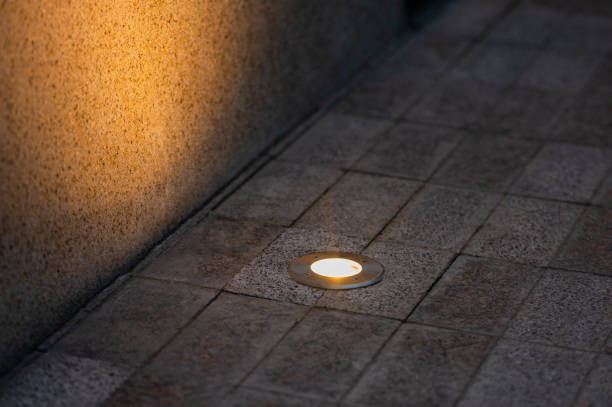Introduction to Exterior Recessed Lighting
Outdoor spaces deserve as much attention as interiors. A well-lit exterior does more than provide visibility; it creates ambiance, enhances security, and increases curb appeal. Among the many outdoor lighting options, exterior recessed lighting stands out as a sleek, modern, and practical solution. Whether you’re updating a porch, illuminating a walkway, or accentuating architectural features, recessed lights deliver clean lines and subtle brilliance.
What Is Exterior Recessed Lighting?
Exterior recessed lighting, sometimes called can lights or downlights, refers to fixtures installed flush with ceilings, soffits, or walls. Unlike hanging or protruding fixtures, these lights sit seamlessly within a surface, offering a minimalist and unobtrusive design. Their primary goal is to provide functional lighting while maintaining architectural harmony.
- Structure: Trim, housing, and bulb integrated within ceilings or soffits.
- Placement: Usually installed outdoors under eaves, decks, porches, and entryways.
- Purpose: Offers directional lighting without cluttering outdoor aesthetics.
Why Choose Exterior Recessed Lighting?
1. Sleek Aesthetic Appeal
Clean, flush finishes make recessed lights nearly invisible until illuminated. Consequently, they complement modern and traditional architecture alike.
2. Enhanced Outdoor Security
Proper lighting deters intruders and makes pathways safer. Strategically placed recessed lights eliminate dark corners around your home.
3. Weather-Resistant Durability
Exterior recessed lights are designed with weatherproof seals, making them resistant to rain, dust, and temperature fluctuations.
4. Energy Efficiency
Modern LED recessed lighting consumes significantly less energy compared to traditional incandescent bulbs, offering long-term cost savings.
5. Increased Property Value
Well-lit exteriors enhance curb appeal, making a property more attractive to buyers.
Common Applications of Exterior Recessed Lighting
Porch and Entryway Lighting
Installing recessed lights above the main entrance not only highlights your doorway but also improves nighttime safety.
Deck and Patio Lighting
Recessed fixtures set within ceilings or floors create an inviting space for outdoor dining or relaxation.
Walkways and Driveways
Placing recessed lights along pathways ensures safe navigation while maintaining a minimalist look.
Soffit Lighting
Soffit-mounted recessed lights accentuate architectural details and eliminate shadows along exterior walls.
Landscape and Garden Lighting
Low-voltage recessed lighting can be integrated into landscaping features to highlight plants, trees, and water elements.
Types of Exterior Recessed Lighting
1. Standard Downlights
These focus illumination directly downward, perfect for pathways, porches, and entryways.
2. Wall Washers
Designed to spread light across a surface, wall washers enhance the visibility of exterior facades.
3. Directional or Adjustable Fixtures
These allow you to aim the beam at specific features, like plants or architectural accents.
4. Step and In-Ground Lighting
Recessed fixtures placed into stairs, decks, or ground surfaces provide safety while offering stylish appeal.
Choosing the Right Exterior Recessed Lighting
Consider Brightness and Color Temperature
- Warm white (2700K–3000K): Creates a cozy, welcoming feel.
- Cool white (4000K–5000K): Ideal for security and visibility.
Select Proper Trim Styles
- Baffle Trim: Reduces glare, suitable for porches.
- Reflector Trim: Maximizes brightness, perfect for driveways.
- Eyeball Trim: Allows directional adjustment.
Prioritize Safety Ratings
Look for UL-rated wet or damp location fixtures to ensure durability against outdoor conditions.
Energy Efficiency Matters
Opt for LED technology with high lumens per watt to save on electricity bills.
Installation of Exterior Recessed Lighting
Step 1: Planning Layout
Before installation, evaluate the space to determine placement, spacing, and purpose of each light.
Step 2: Cutting and Mounting
Cut holes into soffits, ceilings, or designated surfaces. Place the recessed housing securely inside.
Step 3: Electrical Wiring
Connect wiring to a power source, ensuring compliance with safety codes. In some cases, a licensed electrician may be necessary.
Step 4: Sealing and Insulation
Use outdoor-rated housing and seals to prevent water intrusion. Proper insulation also helps maintain efficiency.
Maintenance Tips for Exterior Recessed Lighting
- Regular Cleaning: Wipe lenses and trims to maintain brightness.
- Check Seals: Ensure gaskets remain intact to prevent moisture penetration.
- Replace Bulbs Wisely: Use only outdoor-rated LED bulbs for longevity.
- Monitor Electrical Safety: Inspect wiring annually to prevent hazards.
Design Ideas with Exterior Recessed Lighting
- Highlighting Columns: Place recessed lights at the base of columns to create dramatic upward illumination.
- Perimeter Soffit Lighting: Outline your roofline with evenly spaced lights for a soft glow.
- Deck Floor Lighting: Install recessed fixtures in deck floors for an enchanting evening ambiance.
- Driveway Markers: Embed recessed lights along driveways to guide vehicles safely.
- Poolside Illumination: Use moisture-proof recessed lights to add elegance around pool areas.
Benefits of LED Exterior Recessed Lighting
- Long Lifespan: LEDs last up to 50,000 hours.
- Low Heat Emission: Prevents overheating of fixtures.
- Eco-Friendly: Reduced carbon footprint compared to incandescent lighting.
- Smart Control Options: Many LED fixtures can integrate with smart home systems.
Mistakes to Avoid with Exterior Recessed Lighting
- Overcrowding Fixtures – Too many lights create glare rather than ambiance.
- Using Indoor Fixtures Outdoors – Always choose weather-rated housings.
- Ignoring Energy Ratings – Non-LED lights increase electricity bills.
- Improper Placement – Poor planning can lead to uneven lighting and dark spots.
Cost Considerations for Exterior Recessed Lighting
- Fixture Price: $30–$100 each depending on quality.
- Installation Cost: $100–$250 per light if done professionally.
- Long-Term Savings: Reduced maintenance and energy costs due to LED technology.
Future Trends in Exterior Recessed Lighting
- Smart Outdoor Lighting: App-controlled brightness and scheduling.
- Solar-Powered Recessed Lights: Sustainable energy for eco-conscious homeowners.
- Color-Changing LEDs: Allow mood-setting with dynamic color options.
- Ultra-Slim Fixtures: Modern designs for seamless integration.
Frequently Asked Questions (FAQs)
Q1. What is the main advantage of exterior recessed lighting?
Exterior recessed lighting provides a sleek and modern look while offering functional illumination without cluttering the design.
Q2. Can recessed lights be installed in soffits?
Yes, soffits are one of the most popular locations for recessed lighting since they distribute light evenly across exterior walls.
Q3. Are LED recessed lights better for outdoor use?
Absolutely. LEDs are energy-efficient, durable, and designed for longevity, making them ideal for outdoor applications.
Q4. Is professional installation necessary?
While DIY installation is possible, professional electricians ensure compliance with safety codes and proper waterproofing.
Q5. How far apart should recessed lights be placed?
A general rule is spacing them at 4–6 feet intervals, depending on brightness and purpose.
Q6. Do recessed lights add property value?
Yes. Exterior recessed lighting improves curb appeal, which can increase resale value.

